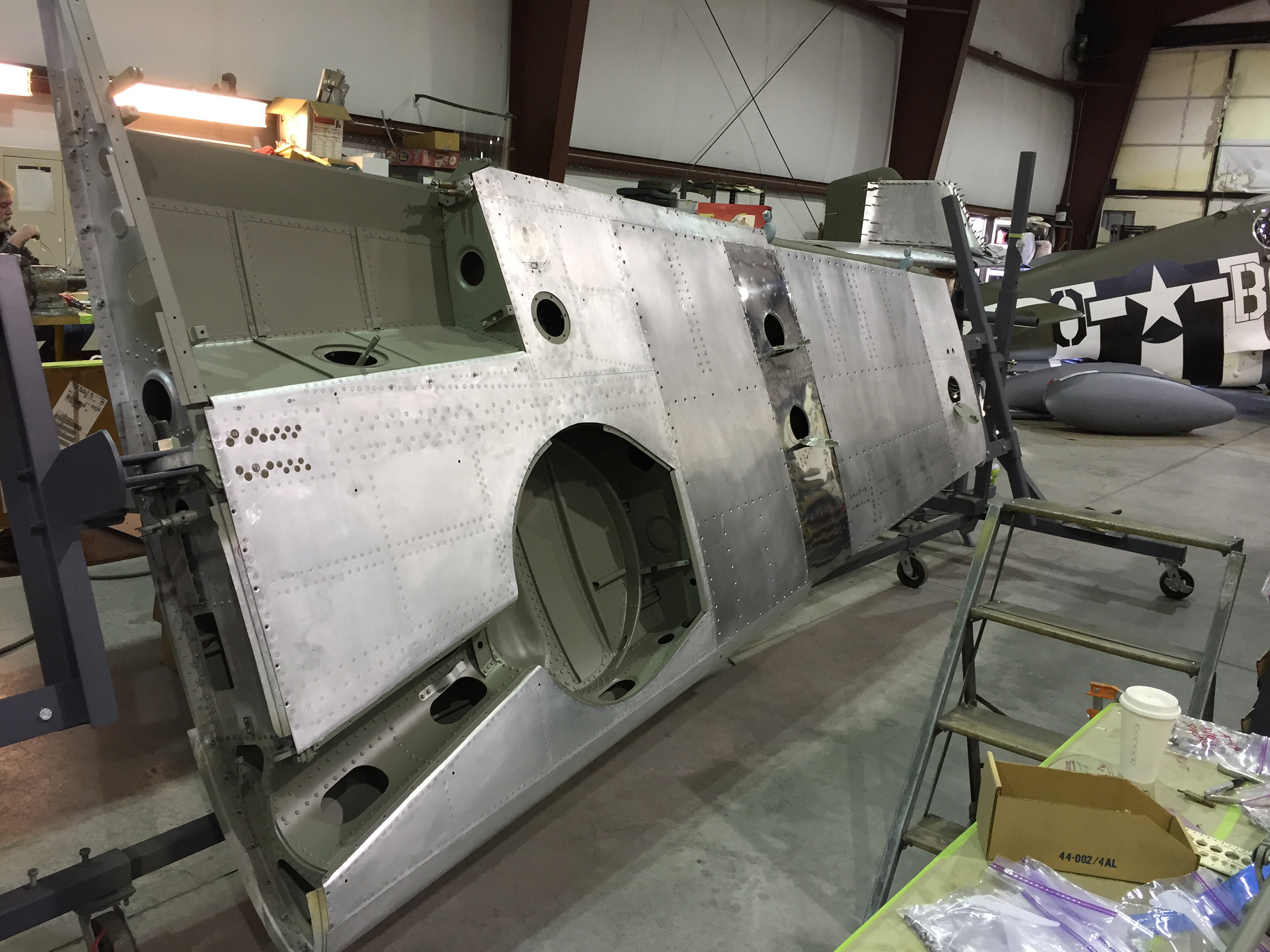

Not content to sit on their laurels following the marvelous restoration of P-51B “Berlin Express”, Pacific Fighters is now hard at work on the restoration of Hispano Buchon C.4K-130 for Jack Erickson’s collection in Madras, Oregon. The aircraft is one of a couple of dozen examples which Group Captain Hamish Mahaddie acquired from the Spanish Air Force during the 1960s to serve as substitutes for their earlier cousin, the Messerschmitt Bf 109, in the movie Battle of Britain. After the movie shoot was complete, one of the pilots, the legendary Wilson “Connie” Edwards acquired the bulk of the remaining airframes, shipping them to his ranch in Big Spring, Texas. Over the years, Edwards parted with most of the Buchons, selling the final six examples just recently. Jack Erickson bought his Buchon from Edwards back in 1989, and it’s been on static display at his museum for most of the intervening years.

The Erickson Aircraft Collection recently contracted Pacific Fighters to undertake an airworthy restoration of the Buchon, converting it to more closely resemble a Messerschmitt Bf 109G. While the Buchon and ‘109 are identical in most respects, there are some significant structural differences, particularly with the powerplant and its cowlings. Much of this was dictated by Hispano choosing the more available Rolls-Royce Merlin engine over the inverted-v Daimler-Benz DB 605 engine of the earlier Bf 109. The engine choice dictated a radical change in the shape of the Buchon’s nose. Converting a Buchon to appear like a Bf 109 is relatively straight forward if you have a spare DB 605 lying around, but since the engine is as rare as hens teeth, and costs a small fortune to make airworthy even when available, Jack Erickson has opted to go a different route. Pacific Fighters is converting the Buchon to use an Allison V-1710 engine, but having an engine mount and exhaust system specially designed to perfectly mimic that of a Bf-109 once housed beneath the correctly profiled and detailed cowlings.

WarbirdsNews talked recently with Pacific Fighter’s John Muszalla II about these efforts, and he related the following… “We have been working on the engine mount and are taking all the proper steps with the engineers and FAA to ensure a safe and proper engine mount installation. We have also made progress on the propeller and spinner, as well as tracking down cowling blue prints and what ever parts we can. The goal of a completely stock outside appearance is really coming together nicely. Exhaust, guns, spinner, carb induction, engine placement and thrust line are all where they should be. We have also been working on the tail [ed. which is slightly different on the Buchon]. We have addressed the issues with the Spanish tail and from there have moved on to the taller G-10 vertical and rudder. The wings are also coming along nicely… We are using the proper RLM colors throughout the plane, and I can tell you that the cockpit will be as authentic as possible. The goal is to have something that can be taken out and flown on a regular basis without the worry of an entire crew or timing out your very rare DB 605 after 150 hours, but also have the look and feel of a Bf-109.”

From the looks of the photographs, this aircraft is set to become another fabulous winner from Pacific Fighters, and we can’t wait to see her take to the air again! WarbirdsNews wishes to thank John Muszalla II very much for his assistance in creating this article, and we look forwards to following this project as it goes from the ground back into the air.
Related Articles
Richard Mallory Allnutt's aviation passion ignited at the 1974 Farnborough Airshow. Raised in 1970s Britain, he was immersed in WWII aviation lore. Moving to Washington DC, he frequented the Smithsonian’s National Air & Space Museum, meeting aviation legends.
After grad school, Richard worked for Lockheed-Martin but stayed devoted to aviation, volunteering at museums and honing his photography skills. In 2013, he became the founding editor of Warbirds News, now Vintage Aviation News. With around 800 articles written, he focuses on supporting grassroots aviation groups.
Richard values the connections made in the aviation community and is proud to help grow Vintage Aviation News.




He’s welcome to restore his fighter in whatever configuration he’d like. But how sad that a Spanish-built airplane that very well may have had combat history is not restored to what it really is – a buchon. With EdA roundels. Why such fascination with the Germans? That’s a Spanish fighter, what a shame it’s heritage and identity is so casually discarded for the sake of the more predominant and “sexy” narrative of iron crosses and swastikas. Lost opportunity, Mr. Ericksen. You’re not just an airplane owner, you’re the caretaker of an important piece of Spanish and world history.
I tend to agree with you Dan. But ultimately, it is up to who pay the bill for the restoration and the Pacific Fighters crew is just doing what the client requested.
Since the very few Spanish 109s weren’t produced with the Merlin until the mid 1950’s I’m pretty sure there is zero combat history of any of them. Much better to restore to a storied version than a postwar afterthought.
It is also better to restore the real Monnalisa instead of copies. But the question is: how many Monnalisa are there?
Show Quality Experience war craft painter looking for a fun project
I for one think this an amazing idea and can’t wait to see it. Hopefully Pacific Fighters will build more QECs for other Hispano 109s out there to convert them so they look more original. A few ugly faced Buchons will always be around. But the more out there flying in authentic looking configuration the better!
Great idea. Too bad Nolan didn’t go through this kind of trouble to ensure the 109’s in Dunkirk were accurate…or at least looked accurate.